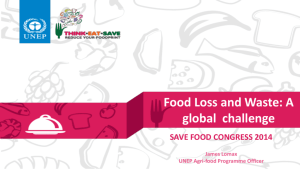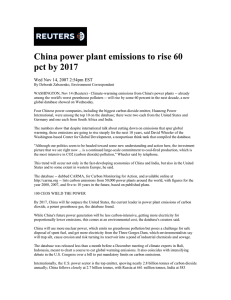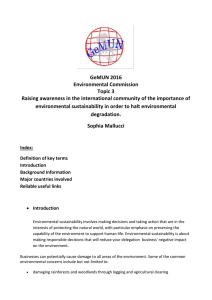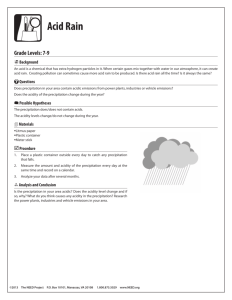MODULE 5: what could THE FUTURE LOOK LIKE?
advertisement
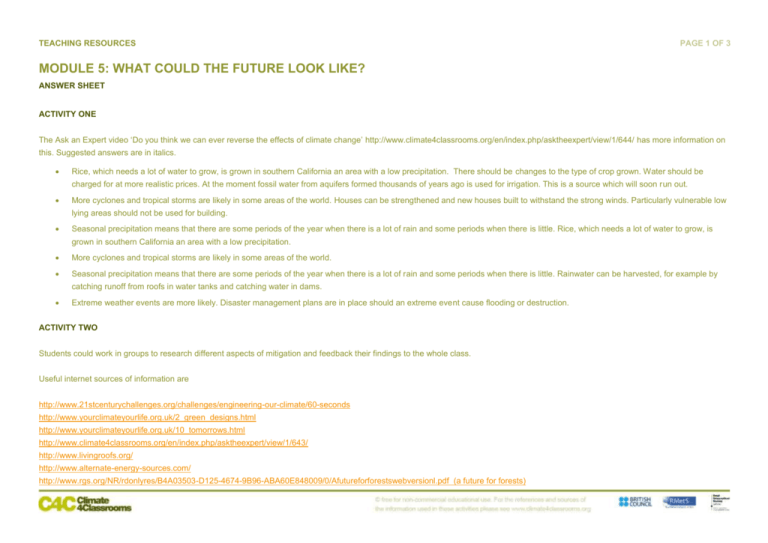
TEACHING RESOURCES PAGE 1 OF 3 MODULE 5: WHAT COULD THE FUTURE LOOK LIKE? ANSWER SHEET ACTIVITY ONE The Ask an Expert video ‘Do you think we can ever reverse the effects of climate change’ http://www.climate4classrooms.org/en/index.php/asktheexpert/view/1/644/ has more information on this. Suggested answers are in italics. Rice, which needs a lot of water to grow, is grown in southern California an area with a low precipitation. There should be changes to the type of crop grown. Water should be charged for at more realistic prices. At the moment fossil water from aquifers formed thousands of years ago is used for irrigation. This is a source which will soon run out. More cyclones and tropical storms are likely in some areas of the world. Houses can be strengthened and new houses built to withstand the strong winds. Particularly vulnerable low lying areas should not be used for building. Seasonal precipitation means that there are some periods of the year when there is a lot of rain and some periods when there is little. Rice, which needs a lot of water to grow, is grown in southern California an area with a low precipitation. More cyclones and tropical storms are likely in some areas of the world. Seasonal precipitation means that there are some periods of the year when there is a lot of rain and some periods when there is little. Rainwater can be harvested, for example by catching runoff from roofs in water tanks and catching water in dams. Extreme weather events are more likely. Disaster management plans are in place should an extreme event cause flooding or destruction. ACTIVITY TWO Students could work in groups to research different aspects of mitigation and feedback their findings to the whole class. Useful internet sources of information are http://www.21stcenturychallenges.org/challenges/engineering-our-climate/60-seconds http://www.yourclimateyourlife.org.uk/2_green_designs.html http://www.yourclimateyourlife.org.uk/10_tomorrows.html http://www.climate4classrooms.org/en/index.php/asktheexpert/view/1/643/ http://www.livingroofs.org/ http://www.alternate-energy-sources.com/ http://www.rgs.org/NR/rdonlyres/B4A03503-D125-4674-9B96-ABA60E848009/0/Afutureforforestswebversionl.pdf (a future for forests) MODULE 5: WHAT COULD THE FUTURE LOOK LIKE? | ANSWER SHEET PAGE 2 OF 3 The ranking exercise is sometimes called a Diamond Nine activity. ACTIVITY THREE TEACHERS We are helping people to become tomorrow’s creatives, responsible for coming up with ideas on how we live with climate change; and, the engineers and business people who will put these ideas into action. At the very least, these eople are going to be tomorrow’s voters, having a say on the future of our planet. So, it’s our job, to help them believe in their potential to make this happen. LOCAL AUTHORITY OFFICALS Climate change is the most important long-term priority for us. It’s as important as public health and sanitation was in Victorian times. The public expects local leadership. That is why many areas have signed up to: o reducing our carbon footprint by 1.5million tonnes by 2012 o reducing carbon emissions by 32million tonnes by 2012 o having an understanding of how climate risks affect our core service delivery, infrastructure, assets and the well-being of local communities. WORLD LEADERS We have the most power to make changes happen. We have had many summits to discuss the state of the planet and try to tackle climate change, such as the Rio Earth Summit in 1992. In 1997and 2005, some of us signed the Kyoto Protocol – to reduce the amount of greenhouse gases that they are pouring into the atmosphere. Each country agreed to cut a certain amount of greenhouse gas emissions. GOVERNMENT MINISTERS We bring together different Departments to make sure the need to adapt to climate change is written into all of our policies. We must raise awareness of the need to take action now and help society prepare for more extreme weather. We will provide grants and tax incentives for energy efficient products such as electric cars and solar panels. We are also working with other countries to help them prepare for the impacts of climate change. Here are some climate promises we have made: by the year 2020, we will reduce greenhouse gas emissions by 26-30% (compared to 1990). by the year 2050, we will cut carbon dioxide emissions by 60%. MODULE 5: WHAT COULD THE FUTURE LOOK LIKE? | ANSWER SHEET PAGE 3 OF 3 BUSINESS PEOPLE The key for us is to see climate change as an opportunity to make money. We need to be quick to respond and predict what people will need. Those of us involved in tourism are monitoring what’s happening in skiing and beach areas to figure out where to invest in next. Those of us involved in agriculture are researching drought as well as damp resistant crops; and those of us involved in construction are avoiding investing in low-lying coastal areas and looking into selling water-saving systems such as rainwater harvesting tanks. Other groups could be farmers, builders, students etc. ACTIVITY FIVE The ‘trees’ could be displayed in the school to give other groups of students the opportunity for discussion.


